Discover the medina of Fez
MEDINA OF FES, THE OLD MOROCCAN CITY PAR EXCELLENCE
The Medina of Fez is one of the best preserved districts of the Muslim world on earth. Its physiognomy has hardly changed since the 12th century!

The medina is an intense and extraordinary urban experience. You’ll have to get out of the busiest streets and onto the rooftops as often as possible to feel the magic of the neighborhood.
The medina includes most of the most beautiful and interesting places in Fez.
1 Map of Fez districts
2 Main attractions in the Medina of Fez
3 Hotels, hostels and Airbnb in the Medina of Fez
4 Fez, the oldest medina in Morocco
5 Medina of Fez : A history of doors
6 The two banks of a valley
7 The Andalusian bank empty of tourists
8 The medina by night
9 Map of Fez : Places of the tourist guide
Map of Fez districts
The Medina of Fez is divided into 2 banks: the Karouanese bank (n°1 on the map) and the Andalusian bank (2). The first one concentrates the majority of the monuments and museums and receives the essential of the visits.
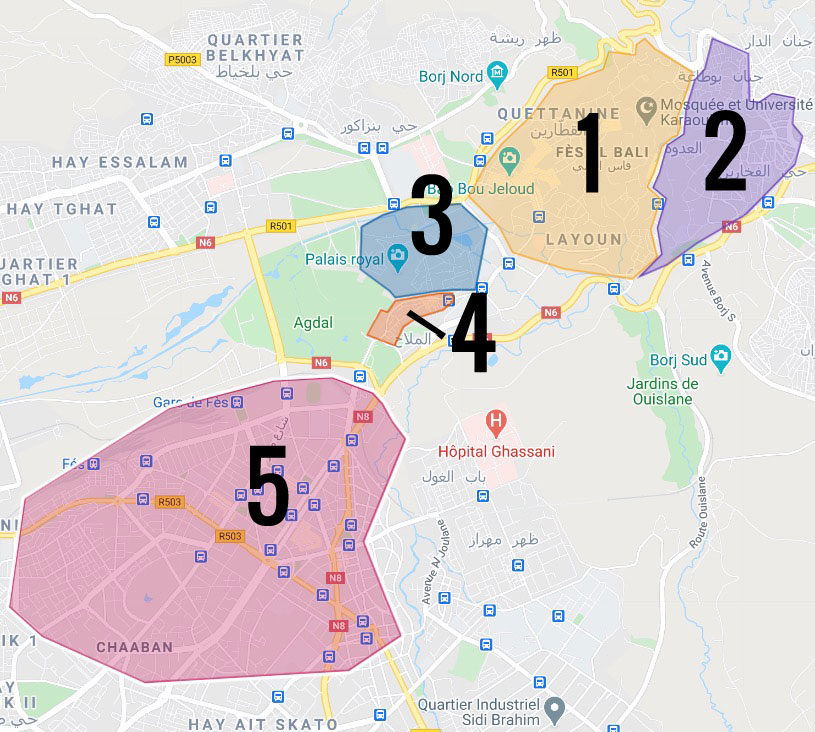
To the west of the Medina is El Jdid (3), the former district of the servants of the Royal Palace and the Mellah (4), the former Jewish district.
Map of the neighborhoods of Fez: 1. medina on the Karouanais bank (the most touristic) 2. medina on the Andalusian bank 3. El Jdid district 4. Mellah, the old Jewish district 4. New City of Fez
Main attractions of the Medina of Fez
Bab Boujloud Gate or blue gate
This is the most majestic and busiest entrance to the old city of Fez and the door to another world.
In front of it, a ballet of cabs between several terraces of cafes facing each other. Behind it begins the Medina, the snack bars, the tourist restaurants (generally to be avoided) and the beginning of a market.
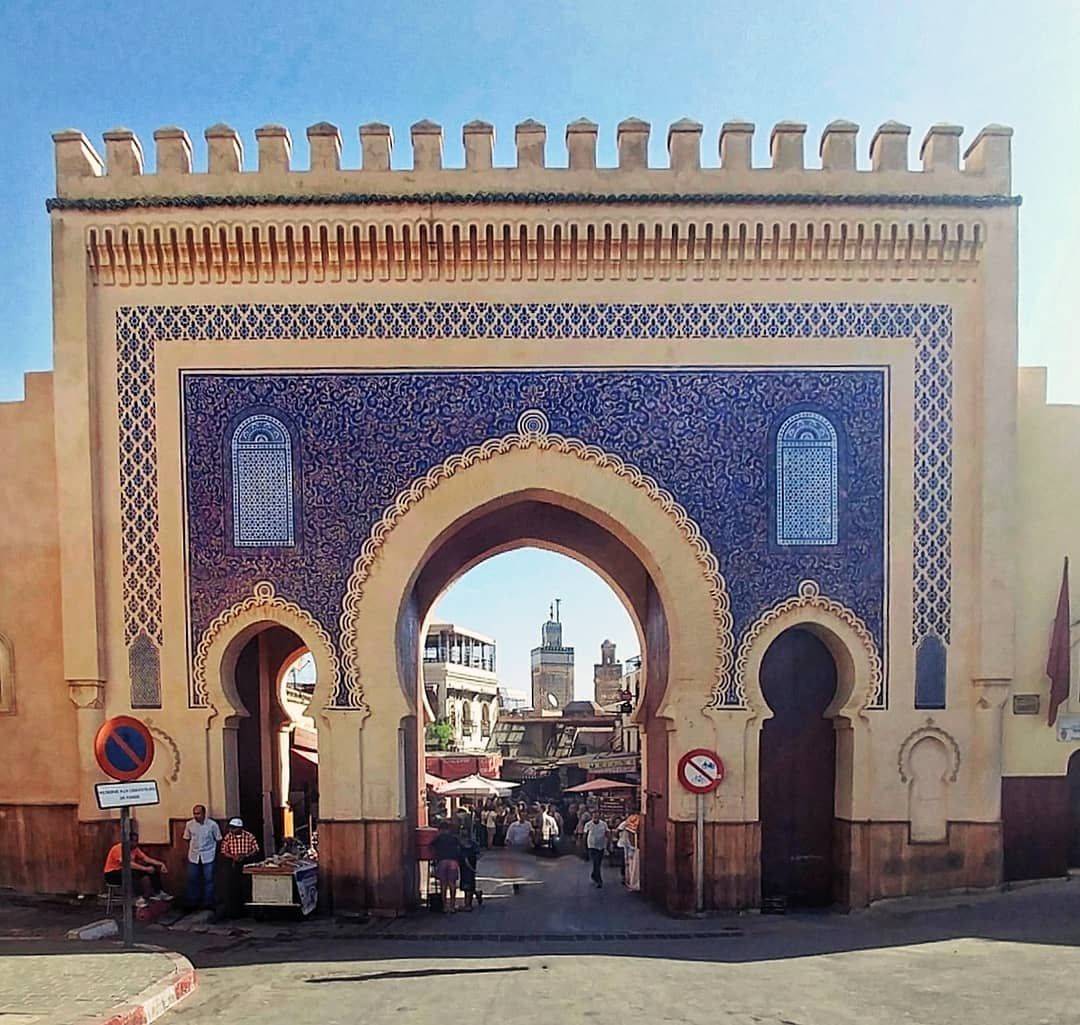
Royal Palace of Fez
The Royal Palace of Fez, built in the 14th century, is one of the largest and oldest in Morocco.
Entrance door of the royal palace
Because of its large size, this palace was built outside the old medina. A new medina, Fez el-Jdid, was therefore created to accommodate the palace.
Nearby is the Jewish quarter (Mellah) which, after having known days of glory, is currently in bad shape.
We will stay at the gates
Like most Moroccan mosques and palaces, it is impossible to visit the royal palace, or even to contemplate its exterior. Once again, visitors must be content with the view of the impressive gates that lead to the palace: the seven different sized gates represent the seven days of the week and the seven levels of the monarchy.
The huge bronze doors are framed by thousands of small ceramic tiles, on which the blue colors of Fez and the green of Islam predominate.
The palace and its surroundings
Going to the gates of the Royal Palace of Fez is worthwhile, not only to contemplate its grandeur, but also to visit the neighborhoods that surround it and discover its contrasts. The houses of the Jewish quarter nearby offer a completely different look from the Muslim style.
The old grain market is another point of interest, which will take you back in time. It is located behind the gate of Bab Sammarine.
Religious architecture.
The most beautiful buildings in Fez are the Muslim places of worship. If you are Muslim, you can visit the Moulay Idriss mausoleum or the Karaouiyne mosque and pray there. For the other atheists, Christians, agnostics, Jews… the mosques are closed since the French Protectorate.
What remains are the medersas, sublime and austere Koranic schools that are both places of instruction and residence for students. Several can be visited, the most beautiful of which are the Medersa Bou Inania, Medersa Attarine and Medersa Sahrij.
Mausoleum Moulay Idriss II in the Medina of Fez
Five centuries after the death of Moulay Idriss II, in 1308, a body found in perfect condition, attributed to the patron saint, transformed the area into a sacred place (Zaouia).
The mausoleum, located in the Place de Marche Verte, began to be built in 1717 and was finished in 1824, since when it is considered the most sacred place in the medina.
Over the centuries, the building has been modified and replaced almost completely. In the 18th century, Moulay Ismail modified it to give it an Alawite style.
The building is part of an architectural ensemble composed of the presumed house of Moulay Idriss, the Al-Araf mosque, the fountain and the masion where ablutions were performed. The complex, known as al-haram (the forbidden), was a place where Muslims could find refuge and asylum.
The shrine is open 24 hours a day, always available for hundreds of Muslims from all parts of Morocco to obtain their blessing.
A sacred neighborhood
The streets surrounding the mausoleum constitute the famous sacred quarter, demarcated by wooden barriers in the streets, which served to prevent Christians, Jews and donkeys from entering the area.
A look from the gate
As with most places in the city, non-Muslims are not allowed to enter the shrine, but you should go to the gate to see it from the outside and get a small view of the imposing building.
From any of the highest points in the city where you can enjoy a panoramic view of Fez, the green pyramidal dome of the Moulay Idriss Mausoleum will always stand out.
In the Medersa Sahrij on the Andalusian side of the Medina of Fez
Nejjarine Museum
The number of artisans working in Fes and their level of excellence are impressive.
You will be able to catch a glimpse of the work at work in the 10,000 workshops of the Medina. For an in-depth look at wood crafts, don’t miss the Nejjarine Museum.
The building is superb, the collection is interesting, the view from the roofs too. You can even drink a mint tea or a strong coffee there.
It is the most interesting museum in Fez. Unlike Marrakech, Fez does not yet have a museum worthy of its rank.
Al Quaraouiyine Mosque
Al Quaraouiyine Mosque is known for housing the oldest university in the world, one of the most important centers of Islamic learning.
Built in 859, under the mandate of Fátima al Fihriya, and constantly expanding since its construction, the Al Quaraouiyine Mosque, also known as Al Qarawiyyin, is one of the largest architectural ensembles in Fez.
The Quaraouiyine Library
Sultan Abu Inan endowed the Quaraouiyine University with a very rich library which, in 1613, exceeded 320,000 works and manuscripts. It was then that students and scholars began to settle in Fez, which became the capital of science and knowledge in the Maghreb.
Nowadays, the library still preserves more than 30,000 works, among which some rare copies and manuscripts unique in the world.
To see it from the door
Despite the remarkable extension of the Al Quaraouiyine mosque, it is difficult to find it because, over the centuries, the houses of the neighborhood have covered the perimeter of the building, thus concealing its shape.
As for the rest of the mosques of Fez, only people of Muslim religion can access the interior of the Quaraouiyine Mosque. Tourists must therefore make do with the small space visible from the door.
Medersa Attarine
Built between 1323 and 1325 under the orders of Sultan Abu Said, the Medersa Attarine is the most beautiful in Fez.
Detail of the tiles of the Medersa Attarine
The Medersa Attarine was one of the main schools of Koranic religion in which students could reside during their studies.
As most of the classes were held in the Al Quaraouiyine mosque, most of the medersas (or madrasas) of the city were located in its surroundings.
This Attarine medersa, so called because of the neighborhood in which it is located, remained in use until the beginning of the twentieth century, when the 60 students who resided in the 30 rooms had to abandon them permanently.
The interior of the medersa
The medersa extends around an inner courtyard in the middle of which stands an imposing marble fountain. At the end of the courtyard, a dome made of cedar wood with abundant ornaments covers the prayer room where you can contemplate the mihrab indicating the direction of Mecca.
The walls of the medersa are decorated with beautiful mosaics on which are inscribed sentences of the Koran.
On the upper part of the walls, you can admire impressive floral patterns.
The upper floors of the Attarine Medersa are occupied by the small rooms in which the young students spent their years of study.
One of the most beautiful
Although in Fez you can visit other medersas, Attarine stands out above all for the elegance and harmony of its architecture. It is one of the best preserved and best decorated medersas in Morocco.
Souks in the medina of Fez
It is impossible to talk about the medina of Fez without mentioning its various souks.
What to say? The stalls are numerous, the offer abundant and of quality, the prices are softer than in Marrakech and the negotiation is otherwise more pleasant in Fez. I am generalizing but this is my experience.
Fondouks, fondouqs. Or caravanserai were places of storage of goods and rest for the caravan of merchants and their animals. It is often a courtyard surmounted by a wrought balustrade.
Recently several fondouqs (Chemmaïne-Sbitriyine, Barka and Staouniyine) have been renovated to accommodate craft cooperatives, exhibition spaces and cafés.
The other doors: Bab Guissa and the others. Fez is surrounded by numerous walls and fortifications. To leave the Medina, you will have to pass through gates. If the most famous is the blue door, there are many others sometimes as monumental.
Tombs of the Merinides
You will have to climb a small hill in the north of the Medina to have the breath cut.
If the Merinides’ tombs are a ruin without much more interest, the view on the old city of Fez is crazy. This tangle of roof terraces, alleys, minarets is a never-ending spectacle.
You have in front of you one of the most prestigious cities of the Muslim world with Mecca, Cairo, Damascus or Baghdad. It is a moment to appreciate at its true value.
Tanneries of Fez.
The Chouara tannery is the largest of the four traditional tanneries still present in the heart of the Fez el-Bali medina. You will find an infinite number of pits filled with natural dyes in charge of the production and coloring of lamb, beef, goat and camel leather.
Process of leather elaboration
The first step in traditional tanneries is to introduce the hides into large vats filled with lime and pigeon droppings, where they rest for several days.
Then, the remaining hair is removed and the hides are dyed by introducing them into large vats filled with natural dyes.
Once the skins are colored and dry, they will be passed on to the artisans who will transform them into bags, suitcases, shoes and coats for sale to the public.
A show of colors and smells
The tanneries are surrounded by stores with terraces where you can watch the hard work of the artisans. At the entrance of the tanneries, you will receive small sprigs of mint that hardly serve to mitigate the very strong and often unpleasant smell.
Despite the unbearable stench, the Chouara tannery is one of the most typical and representative places in the city and it is essential to visit it to get to know Fez.
It is very common that the sellers try to make tourists buy a piece of leather for attending this show, but with a small tip, they will be satisfied.
Bab Guissa cemetery
The cemetery borders the Medina and the Merinid Tombs. Beyond the unusual side of seeing flocks of sheep weeding the place, it is the rural landscape that is to be enjoyed.
The green, flowery hills planted with olive trees give the surrounding countryside a timeless, sweet and charming mythological aspect.
The medina. The most beautiful attraction of the old city remains its urbanistic organization. It is extra-ordinary. 14,000 buildings, 700 of which are of great value, spread over 350 hectares.
Every great Arab city in Africa or Asia has a medina, but that of Fez is one of the oldest, most beautiful and largest in the world.
Because the Medina is above all a labyrinth, here are some tips to help you find your way around and maps of Fez to download.
Fez, the oldest medina in Morocco
The medinas are the old Arab cities built around a mosque marking the spiritual but also economic heart of the city. The luxury shops are closest to the mosque (kissaria). The industries considered dirty (tannery) as far as possible.
The Medina of Fez is characterized by a great mix of human activities. They form a space where residential, economic, social and cultural functions are juxtaposed:
In the commercial districts of the souks, squares allow the display of products and the conclusion of sales.
The residential areas, on the other hand, are sheltered by windowless walls, at the end of dead ends around courtyards and gardens invisible from the street.
In the industrial districts, the noise of the weavers, the blacksmiths, the shoemakers compete for attention with the smell of the miller’s oils or the tanner’s hides or that passing donkey.
Among the craftsmen of the Medina, you will find : Carpenter, tanner, boilermaker, blacksmith, saddler, leatherworker, bellows maker, alembic maker, demasquineur, baker, butcher… 10,000 workshops in Fez. The opposite of a museum city.
The medina urbanism invented in the Middle Ages includes the concepts considered today as the most innovative in terms of environment: bio-climatic architecture, pedestrian city, high density, compactness, low environmental impact…
Medina of Fez : A story of doors
There are several accesses to the Medina through the old fortifications and ramparts.
The medina is a closed world where doors answer to narrow streets.
> The medina is a closed world where doors answer to narrow streets.
The blue door (or Bab Boujloud) located at the west is the most famous.
Main door of the medina, several cafes face each other, a line of cab constantly renewed in the center. People go in and out of the old city, take a break, adjust the frame, and immortalize the beautiful blue door.
A few steps inside the medina you will find a small square with many snacks and restaurants. The hungrier and less curious won’t drink to eat anymore. Unless they have already gone around and back to the starting point.
The Bab Guissa gate is located to the north near the Merinid tombs.
It opens onto a less touristy and more residential neighborhood marked by its heady smell of wood. It is the district of the carpenters and the streets smell an invisible forest of cedars, thuja and pines.
Wood is still a raw material that is widely used throughout the Old City: for construction, renovation, making tools and various objects. It is not uncommon to see a narrow wagon loaded with heavy beams coming down the narrow streets. The man in a hurry and his docile horse at work. Today as well as 1000 years ago.
In the carpenters’ district near the Bab Guissa gate in the medina of Fez.
The two banks of a valley
Behind the walls and dust of the old city, one would almost forget that Fez is a city of water drowned in a green countryside.
The medina is built in a valley (or a basin). The lowest part of the Medina corresponds to the river separating the bank of the Karouanais (west of the Medina, the most touristic part, n°1 on the map) from the bank of the Andalusians (east, n°2)
If you want to go in the direction of Bab Boujloud (the blue gate, main entrance to the Medina), be careful to go west (hence the need for a compass).
Bab Boujloud is indicated on directional signs across the west bank, the signs disappear on the east bank.
In other words, it is not enough to go up the slope to take the right direction, as both banks are sloping.
The Andalusian bank empty of tourists
The Andalusian bank (n°2 on the map at the top) is shunned by tourists for “practical” reasons. Most of them arrive in the Medina to the west. The western part therefore concentrates accommodation, western-style cafes, restaurants, but also monuments and museums.
The Andalusian bank also has a rich architectural heritage, but its discovery is just not particularly facilitated by the opening of sites to visit, by the establishment of a signage or edition of map.
The Andalusian bank remains “Moroccan”, more snacks than restaurants, cafes with only men, almost no one to “guide” you without your knowledge or sell you anything.
And once again, almost no tourists. Unknown, this bank has less good reputation, hard to know if right or wrong. Stick to the main streets and you won’t have any bad surprises. And probably no bad surprises either when you leave the main streets.
The medina at night
Fez goes to bed early. This does not prevent you from listening to some music.
If the experience of the Medina by day has left you perplexed. Avoid walking around at night or staying on the main streets. The orientation is less easy, the open stores rarer, the situations more anxiety-provoking.
Women, children and old people have disappeared and what remains are young men, beggars and crazy people. Many smoke hash or kif, some sniff glue, fewer are drunk.
There are also people who just pass by. But here it can be a nice romantic stroll for a couple or a bit stressful. Heads or tails.
To stay in the Medina: Our selection of nice, value-for-money riads in Fez.
Map of Fez : Places of the tourist guide
Find all the places in the guide to visit on the map of Fez (Morocco): Riads and accommodations according to your budget, monuments not to be missed, interesting museums, parks and relaxing nature spots, tasty and cheap restaurants…
Good plan ! You can download the map for free for offline use.
DISCOVER OUR TOURS TO SAHARA DESERT IN MOROCCO
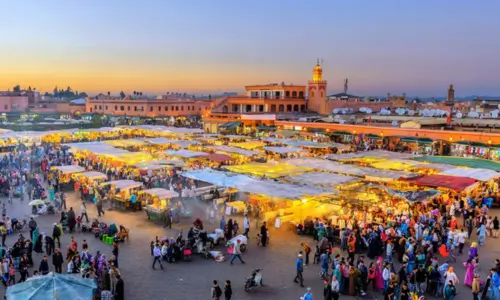
FROM MARRAKECH
Our most popular Morocco Sahara Tours . The trip from Marrakech is rich in scenery and includes an unforgettable stay in a Desert Camp.
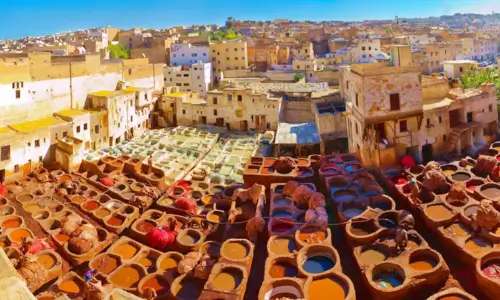
FROM FES
A great experience starting from Fes including camel trekking and at least one night in a tented desert camp in the Merzouga Desert.
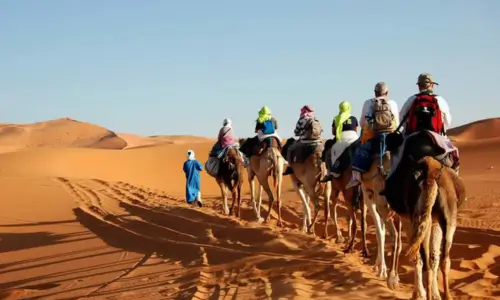
CUSTOM TOURS
Our experts can create exceptional tailor-made experiences for our clients. Contact us and we´ll plan your perfect trip in Morocco.

